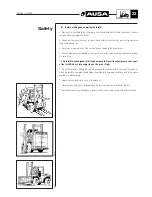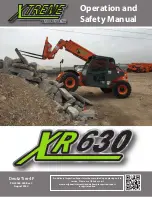
34
CH 200 / CH 250
Periodic
Maintenance
Operations
Hydraulic steering and load handling safety valves (fig.1 and 2)
There are safety relief valves on both the hydraulic steering block and on the load handling cir-
cuit. The lines in figure 1 and 2 show the plugs where the hydraulic steering pressure (1) and the
load control hydraulic pressure (2) are adjusted. Although they are set at the correct working
pressure at the factory, if the hydraulic system fails these safety valves must be reset. However
this work must only be done by trained mechanics with knowledge of hydraulics and correct
pressure gauge tools. The pressure must not be set higher than set forth in "Technical
Characteristics" in this Operators Manual.
-Steering Block Valve:
Take off the cap (1, fig.1) and turn the screw underneath clockwise to
increase the hydraulic pressure.
-Safety Relief Valve:
This valve is located on the left side of the chasis, under the cabin, next to
the hydraulic filter. It controls the maximum working pressure of the appliances hydraulic circuit.
For setting it, take out the cover nut (1, fig.2) and turn the screw underneath clockwise to increa-
se the hydraulic pressure.
Tyres pressure
It is recommended that experienced tyre personnel should only do tyre inflation, as tyre inflation
can be dangerous if not done with care. The following procedure steps should be taken when
inflating the tyres, with special caution exercised when working on the front axle tyres.
- Park the machine on level ground and turn the engine off.
- Always wear goggles to prevent injury from an unforeseen air jet.
- Always inflate tyres before it has been operated and the tyres are still cold. When inflating a tyre
do not stand in front of the tyre but stand laterally at the side.
- The inflation valve must be secured with a clamp to prevent a possible whip lash if the valve is
suddenly disengaged.
- Check tyre air pressure with a tyre pressure gauge. Only inflate tyres to the level recommended
by the tyre manufacturer.
- If a tyre is inflated after being removed from the forklift, the tyre should only be inflated after it
has been placed under a protective cage.
Forklift mast chain (fig. 4)
The length of the mast chain should be checked every 1000 hours. When the forklift is delivered
to the owner, the length of the mast chain must be measured and noted in a permanent record.
The chain must be replaced when their length has increased 3%. To tighten the mast chain, loose
and tight the nuts arrowed.
Overhead guard structure
This structure must be inspected weekly for excesive damage, cracks, permanent deformation or
signs of potential cracks. In this case, structure must not be repaired but replaced for a new one.
(fig. 4)
(fig. 2)
(fig. 3)
1
(fig. 1)
1
Содержание CH 200
Страница 1: ...CH 200 CH 200 x4 CH 250 CH 250 x4 OPERATOR S MANUAL ENGLISH ...
Страница 2: ...AUSA Forklift CH 200 CH 200 4x4 CH 250 CH 250 4x4 ...
Страница 3: ......
Страница 11: ...11 CH 200 CH 250 Machine decals USA market Information ...
Страница 12: ...12 CH 200 CH 250 Machine decals USA market Warning Load charts ...
Страница 13: ...13 CH 200 CH 250 Machine decals UK market Information ...
Страница 14: ...14 CH 200 CH 250 Load graphs Machine decals UK market ...
Страница 37: ...37 CH 200 CH 250 Electric circuit CH200 1 ...
Страница 38: ...Electric circuit CH200 2 38 CH 200 CH 250 ...
Страница 39: ...Electric circuit CH200 3 39 CH 200 CH 250 ...
Страница 40: ...Electric circuit CH200 4 40 CH 200 CH 250 ...
Страница 42: ...Electric circuit CH250 1 42 CH 200 CH 250 ...
Страница 43: ...Electric circuit CH250 2 43 CH 200 CH 250 ...
Страница 44: ...Electric circuit CH250 3 44 CH 200 CH 250 ...
Страница 45: ...Electric circuit CH250 4 45 CH 200 CH 250 ...
Страница 47: ...Hydraulic diagram Side shift 1 47 CH 200 CH 250 ...
Страница 48: ...Hydraulic diagram Hydromatik CH200 1 48 CH 200 CH 250 ...
Страница 49: ...Hydraulic diagram Hydromatik CH250 1 49 CH 200 CH 250 ...
Страница 51: ......





































